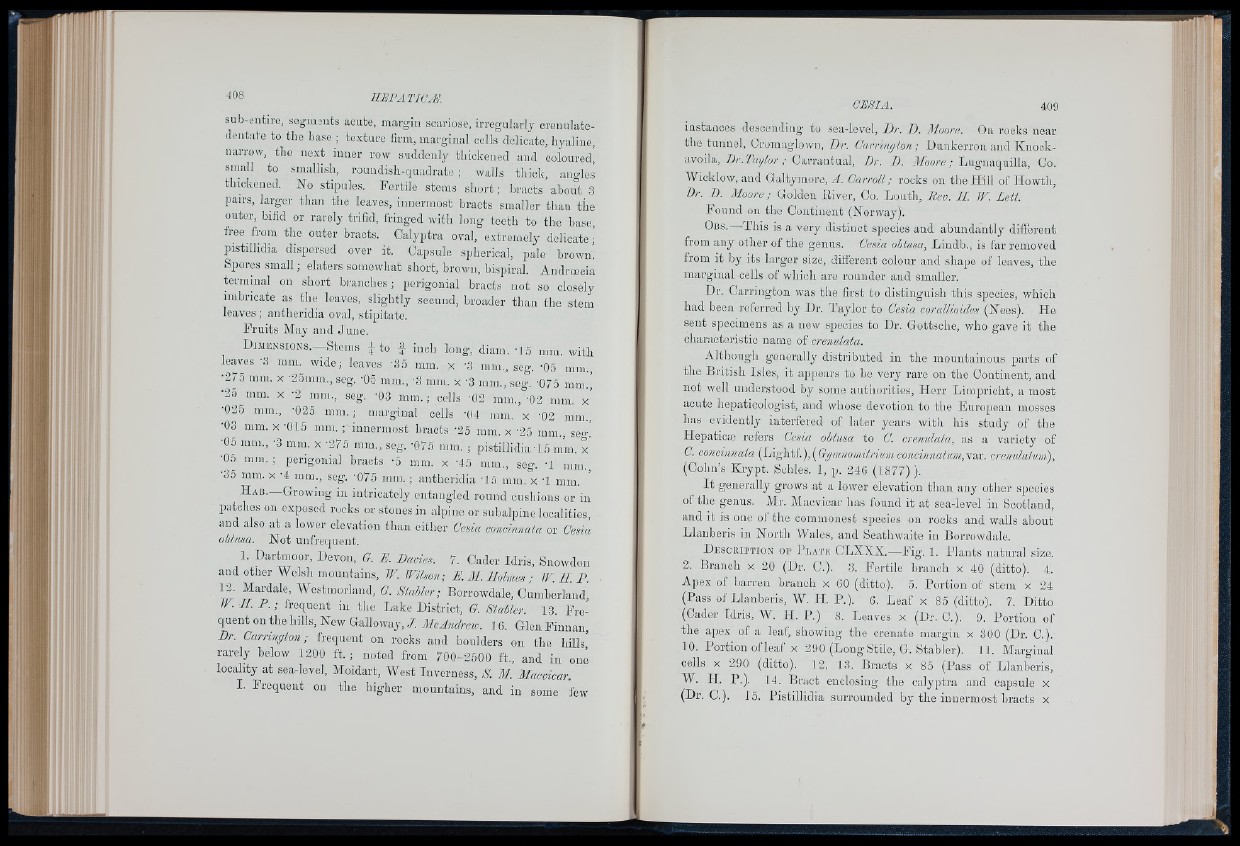
sub-L'utire, segments acute, margin soariose, irregularly crenulate-
(leutate to the base ; texture firm, marginal cells delicate, hyaline,
narrow, the next inner row suddenly thickened and coloured!
small to smalhsh, rouudish-quadrato ; walls thick, angles
thickened. No stipules. Fertile stems short ; braots about 3
pairs, larger than the leaves, innermost braots smaller than the
outer, bifid or rarely trifid, fringed with long teeth to the base,
free from the outer bracts. Calyptra oval, extremely delicate!
pistilhdia dispersed over it. Capsule spherical, pale brown.
Spores small ; elaters somewhat short, brown, hispiral. Androecia
terminal on short branches; perigonial bracts not so closely
imbrioate as the leaves, slightly secund, broader than the stem
leaves ; antheridia oval, stiqiitate.
Fruits May and June.
DiiiENSioNS.-Stems 4 to f inch long, diam. T5 mm. with
leaves '3 mm. wide; leaves -35 mm. x '3 mm., seg. '05 mra.,
•275 mm. x •25mm., seg. -05 mm., -3 mm. x -3 mm., seg. -075 mm.,
•2o mm. X -2 min., seg. -03 mm.; cells -02 mm., -02 mm. x
•025 mm., -025 mm. ; marginal cells -04 ram. x -02 mm.,
•03 mm. X -015 mm. ; innermost braots -25 mm. x -25 mm., seg!
■05 mm., -3 mm. x -275 mrn., seg. -075 mm. ; p istillid ia -15 m’m. x
•05 mm. ; perigonial bracts -5 mm. x -45 mm., seg. -1 mm.
•35 mra. x -4 mm., seg. -075 mm. ; antheridia -15 mm. x -1 mm. ’
H ab.— Growing in intrioately entangled round ensilions or in
patches on exposed rocks or stones in alpine or subalpine localities,
and also at a lower elevation than either Cesia conciunata or Cesia
obi usa. N o t unfrequent.
1. Dartmoor, Devon, G. E. Envies. 7. Cader Idris, Snowdon
and other Welsh mountains, IP. Wilson; E. M. liolmes : W. II. P.
12. Mardale, Westmorland, G. Stabler; Borrowdale, Cumberland,
W. II. P .; I'reqiient in the Lake District, G. Stabler 13 Frequent
on the hills. New Galloway, J. McAndrezv. 1 6. Glen Finnan,
Er. Carringlon ; frequent on rocks and boulders on the liills^
rarely below 1200 ft. ; noted from 7 0 0 -2 5 0 0 ft., and in oim
locality at sea-level, Moidart, West Inverness, A. M. Macvicar.
I. Frequent on the higher mountains, and in some few
instances descending to sea-level, Dr. D. Moore. On rooks near
the tunnel, Cromaglown, Dr. Carringhn; Dunkerron and Knockavoila,
Dr.Iuglor ; Carrantual, Dr. E. Moore; Lugnaquilla, Co.
Wicklow, and Galtymore, A. Carroll ; rocks Oil the HÜ1I of liowth,
Er. D. Moore ; Golden iiiver, Co. Louth, Rev. II. W. Lett.
Found on the Continent (Norway).
Obs.—This is a very distinct species and abundantly different
from any other of the genus. Cesia obtusa, Lindb., is far removed
from it by its larger size, difiereiit colour and shape of leaves, the
marginal cells of which are rounder and smaller.
Dr. Carrington was the first to distinguish this species, which
had been referred by Dr. Taylor to Cesia corallioides (Nees). He
sent specimens as a new sjiecies to Dr. Gottsche, who gave it the
charaoteristio name of crenulata.
Although generally distributed in the mountainous parts of
the British Isles, it appears to be very rare on the Continent, and
not well understood by some authorities, Herr Limpricht, a most
acute hepaticologist, and whose devotion to the European mosses
has evidently interfered of later years with his study of the
Hepaticæ refers Cesia obtusa to C. crenulata, as a variety of
C. conoinnala ffi\ffi\ii.'),(Ggiiinom,ilriuni concinnatiiin,\ai-. crenulatum),
(Cohn’s Krypt. Schles. 1, p. 246 (1877)).
I t generally grows at a lower elevation than any other species
of the genus. Mr. Macvicar has found it at sea-level in Scotland,
and it is one ol the coimnoiiest sqreoies on rocks and walls about
Llanberis in North Wales, and Seathwaite in Borrowdale.
DnscRii’TioN OE I ’ljATE CLXXX.—Fig. 1. Plants natural size.
2. Branch x 20 (Dr. C.). 3. Fertile branch x 40 (ditto). 4.
Apex of barren branch x GO (ditto). 5. Portion of stem x 24
(Pass of Llanberis, W. H. P.). 6. Leaf x 85 (ditto). 7. Ditto
(Cader Idris, W. H. P.) 8. Leaves x (Dr. C.), 9. Portiou of
the apex of a leaf, showing the crenate margin x 300 (Dr. C.).
10. Portion of leaf X 290 (Long Stile, G. Stabler). 11. Marginal
cells X 290 (ditto). 12. 13. Bracts x 85 (Pass of Llanberis,
W. H. P.). 14. Bract enclosing the calyptra and capsule x
(Dr. C.). 15. Pistillidia surrounded by the innermost bracts x